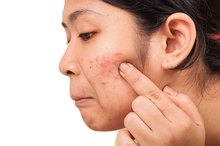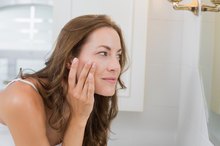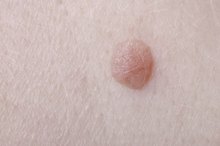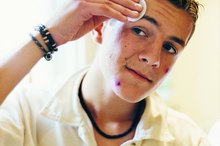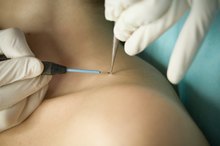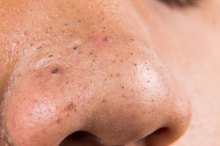What does fact checked mean?
At Healthfully, we strive to deliver objective content that is accurate and up-to-date. Our team periodically reviews articles in order to ensure content quality. The sources cited below consist of evidence from peer-reviewed journals, prominent medical organizations, academic associations, and government data.
- National Institute of Arthritis and Musculoskeletal and Skin Diseases; Acne, Questions and Answers About Acne; October 2010
- PubMed Health; Acne; October 2010
- PubMed Health; Acne; October 2010
The information contained on this site is for informational purposes only, and should not be used as a substitute for the advice of a professional health care provider. Please check with the appropriate physician regarding health questions and concerns. Although we strive to deliver accurate and up-to-date information, no guarantee to that effect is made.
How to Determine if a Face Blemish Is a Wart or Pimple
Facial blemishes are highly noticeable because of their location. Pimples are common facial blemishes. Facial warts are less common, as are bug bites, scratches and sores from other causes. You must know the blemish type to treat it properly. Pimples and warts both have distinguishing characteristics that let you tell them apart if you study them closely.
Definition
Pimples come from acne, a common skin disorder among teens and some adults. Some are simply swellings caused by blocked pores, while others get pus inside or turn into hard bumps. Warts are abnormal skin growths caused by a virus. Pimples most commonly appear on the face, although acne can affect your chest, shoulders, back and other areas. Warts are more likely to grow on your fingers, hands and feet, although two types tend to grow on your face, according to KidsHealth.org 2. You can tell these two skin problems apart mainly by their appearance.
- Pimples come from acne, a common skin disorder among teens and some adults.
Wart Characteristics
Acne & Warts
Learn More
Facial warts primarily come in two types. Flat warts are tiny and smooth, usually growing no larger than a pinhead and appearing in clusters, while filliform warts are larger and shaped like a thin finger, according to the American Academy of Dermatology. Filliform warts are the same color as your skin and generally appear by your eyes, nose or mouth, while flat warts vary in color. They may be pink, yellow or light brown and appear anywhere on your face, as well as on your hands, arms and knees. You can also get a common wart on your face, which is a rough bump that may be dotted with small black specks. Warts can spread, since they are viral, and washing helps prevent them.
- Facial warts primarily come in two types.
- Filliform warts are the same color as your skin and generally appear by your eyes, nose or mouth, while flat warts vary in color.
Pimple Characteristics
Pimples have several lesion types, like blackheads, whiteheads, pustules, papules, nodules and cysts. Some pimples are barely noticeable, while others are large, inflamed and likely to cause a scar. Acne varies in appearance from small pink or red bumps with a black, white, or yellow top, depending on whether the follicle is partially or completely blocked and whether it is inflamed, according to the National Institute of Arthritis and Musculoskeletal and Skin Diseases 1. Pimples range in size from small bumps to large, deep cysts. Dead skin cells and excess skin oil causes acne. Washing does not prevent pimples and sometimes worsens them if you scrub too roughly or use inappropriate products.
- Pimples have several lesion types, like blackheads, whiteheads, pustules, papules, nodules and cysts.
Considerations
What Causes Warts on the Face?
Learn More
Acne lesions tend to heal, while warts are more persistent, but both conditions are highly treatable. Acne treatments come in many convenient forms, like creams, washes, cleansers, wipes, lotions and pads, most of which use salicylic acid, sulfur, resorcinol or benzoyl peroxide as the primary ingredient. Drugstores and other big retailers sell these remedies. Salicylic acid is also sold as an over-the-counter wart fighter for blemishes on your hands, feet and other areas, but such products are not for facial use except on a physician's advice. Visit your doctor if you are unsure about whether a particular facial blemish is a wart or pimple.
- Acne lesions tend to heal, while warts are more persistent, but both conditions are highly treatable.
- Salicylic acid is also sold as an over-the-counter wart fighter for blemishes on your hands, feet and other areas, but such products are not for facial use except on a physician's advice.
Related Articles
References
- National Institute of Arthritis and Musculoskeletal and Skin Diseases; Acne, Questions and Answers About Acne; October 2010
- KidsHealth.org; Infections, Warts; November 2010
- Campaner AB, Cardoso FA, Fernandes GL, Veasey JV. Verrucous carcinoma of the vulva: diagnosis and treatment. An Bras Dermatol. 2017;92(2):243-245. doi:10.1590/abd1806-4841.20174929
- TeensHealth. Warts. Updated February 2019.
- Vlahovic TC, Khan MT. The Human Papillomavirus and Its Role in Plantar Warts: A Comprehensive Review of Diagnosis and Management. Clin Podiatr Med Surg. 2016;33(3):337-53. doi:10.1016/j.cpm.2016.02.003
- Yanofsky VR, Patel RV, Goldenberg G. Genital warts: a comprehensive review. J Clin Aesthet Dermatol. 2012;5(6):25–36.
- Johns Hopkins Medicine. Warts in children.
- Patidar S. Combination treatment of periungual warts. J Cutan Aesthet Surg. 2008;1(1):23–24. doi:10.4103/0974-2077.41154
- Al Aboud AM, Nigam PK. Wart (Plantar, Verruca Vulgaris, Verrucae). StatPearls. Sept 27, 2019.
- Yanofsky VR, Patel RV, Goldenberg G. Genital warts: a comprehensive review. J Clin Aesthet Dermatol. 2012 Jun;5(6):25-36.
Writer Bio
Based in Kissimmee, Fla., Barb Nefer is a freelance writer with over 20 years of experience. She is a mental health counselor, finance coach and travel agency owner. Her work has appeared in such magazines as "The Writer" and "Grit" and she authored the book, "So You Want to Be a Counselor."
